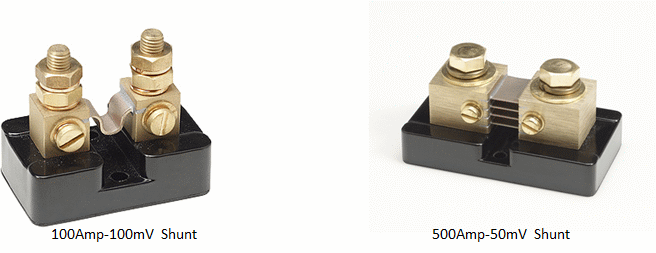What: Electrical shunts are high precision, temperature stable electrical resistances whose resistance is precisely known.
Why: Electrical shunts are used to measure electrical currents.
How: Measuring an electrical current using a shunt makes use of Ohm’s Law which states that the voltage drop across a resistance is proportional to the current flow through the resistance.
By measuring the voltage drop (‘electrical pressure’) across the shunt and knowing its resistance allows one to compute the current flow through the shunt.
Electrical shunts are usually specified by the maximum current flow they can handle and the voltage drop that occurs across the shunt at that current. For example, a 500 Amp – 50 mV shunt is capable of conducting a peak current of 500 Amps and produces a voltage drop of 50 milli-Volts (0.050 Volts) at that peak current flow.
Electrical shunts are installed at the point in an electrical circuit where the current needs to be monitored. If one desires to measure the overall current flow into and out of a battery bank, the shunt is placed on the main negative line of the circuit, through which *all* current must flow. One side of the shunt is connected to the battery bank’s negative and the return (negative) wire from *every* DC appliance and charger is connected to the “load” side of the shunt.
How to select a shunt: In order to determine the shunt size for your rig, first determine the highest, sustained current draw you’re likely to experience in your daily usage. For example, if you have a 110 VAC microwave oven that is operated off a 12 VDC inverter, then the peak sustained current draw is very likely to be over 100 Amps.
If the peak sustained current draw is over 80 Amps, a 500 Amp/50 mV shunt is recommended.
Instances where a 500 Amp shunt may be needed – 110 VAC coffee maker, hair dryer or any high power appliance that are powered by the battery bank. In all these instances, the peak current flow from the battery is likely to be well over 100 Amps. If the peak sustained current draw is less than 80 Amps, a 100 Amp-100 mV shunt would work.
In general, peak charging current does not influence shunt selection since the charging current is unlikely to be 80 Amps or more.
To buy a shunt or one of our other products, please follow the link below.
